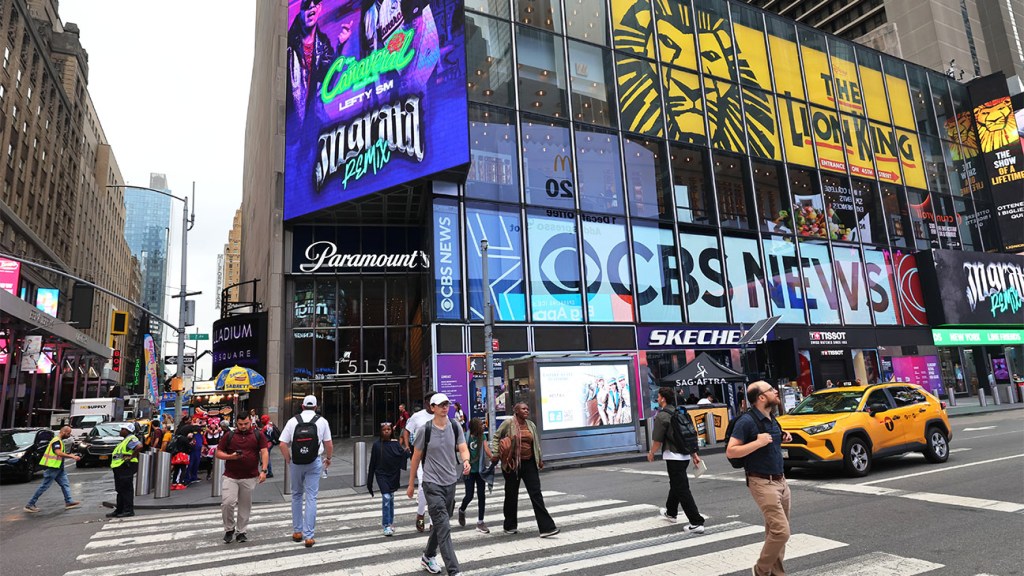U.S. advertising revenue, excluding political ads, will grow 5 percent in 2023 and 4.3 percent in 2024, but national TV may be facing a moment that some see as an “existential crisis,” Brian Wieser, principal at Wall Street insights provider Madison and Wall, said in a new forecast on Wednesday.
When including political ads, total U.S. advertising revenue will hit $363 billion in 2023, up 2percent, and grow 8.1 percent in 2024, he projected, speaking of “a return to normalized growth for U.S. advertising.”
Wieser’s report touches on such topical issues as the consequences of the Hollywood strikes and the Disney-Charter Communications carriage dispute, as well as explanations for how the advertising industry should evolve over the rest of this year and beyond. It provides data through 2028, from 2016 on an annual basis, and from 2018 on a quarterly basis. The data, based on his assessment of approximately 80 companies’ public filings and U.S. government data, is more detailed than many other forecasts. The expert also breaks out digital-only publishers as part of the broader “publishing” category, which he told The Hollywood Reporter he hopes can serve as “a more complete proxy for ad-supported journalism and related content.”
The U.S. advertising industry experienced a period of “massive expansion” during the COVID pandemic, following a “fairly good end” to the 2010s, which also represented a period of above-trend growth both in terms of its own history and the economy,” Wieser wrote in his report. “Looking forward, it’s highly unlikely that such trends could continue. Instead, I expect a reversion back towards the lower end of mid-single-digit levels, which should be considered normal, positive conditions for the industry.”
While some factors behind the last decade’s expansion are continuing, including “increasingly significant cross-border ad budget flows from China into the U.S.” and the growing ease of buying ads for small businesses, others won’t continue or return, the report argued. “Specifically, a decade of low capital costs meant that it was relatively easy – and desirable – for businesses to raise vast sums of money and in turn deploy much of it into advertising pursuit of sometimes profitless growth,” Wieser explained. “With the scale of investment that we saw in areas such as crypto-currencies, rapid delivery, and direct-to-consumer consumer goods, among others, it’s hard to anticipate new categories which could replace them as growth drivers.”
Picking up on the ad market challenges that media and entertainment industry CEOs and analysts have often highlighted over the past year amid repeated talk about macro-economic clouds, the expert concluded: “If anything, it could be considered a positive that the industry didn’t fall faster, or even decline over the past year and a half, especially as much of the industry seemed to try to talk itself into a downturn last year by fearing for a recession that never came.”
Even high inflation should have boosted the overall ad market, Wieser argued. “Most marketers I have studied manage their budgets for advertising on a percentage-of-revenue basis,” he explained. “Higher revenue, whether driven by higher prices or higher volumes, should almost always lead to more spending on advertising unless there is a meaningful decline in underlying economic growth.”
Either way, he sees post-pandemic conditions normalizing as the advertising market laps unusually soft year-ago quarters. His conclusion: “After growth of 6 percent in the third quarter of this year and 8 percent in the fourth quarter (following on growth of 3.5 percent and 0.1 percent for the third quarter 2022 and fourth quarter 2022, respectively), I expect growth to normalize in a 4-5 percent range excluding the effects of political advertising.”
After all, political advertising has become an ever bigger factor. In 2024, Wieser sees it hitting approximately $17 billion, up from $14 billion in 2020 and $6 billion in 2016. “Political advertising has become an increasingly important component of almost all forms of media, not only local broadcasting, where it will likely retain an outsized role given its effectiveness in driving election outcomes,” he said. “However, internet-related advertising has become increasingly important, and as this category continues to grow, its year-over-year skews to growth rates will become increasingly evident.”
National TV, however, is an area of concern. “Significant challenges get worse from here,” Wieser warned in a section about it. “The television advertising sector is experiencing what might feel like an existential crisis at the moment. At the start of this year, we had a situation where cord-cutting was accelerating into high-single-digit levels of decline, enabled (if not outright encouraged) by traditional TV network owners’ shift of resources and programming budgets into streaming platforms, which have been and are likely to always be ad-free or ad-light at best. ] And then we had the Hollywood strikes, which increasingly look like they will have a meaningful impact on the production of what’s left of ad-supported entertainment programming, and thus the availability of inventory to meet marketer goals in the latter part of this year as well as the early part of next.”
Last week, another shoe dropped in the form of Disney TV channels’ blackout in Charter homes amid a carriage fee dispute, which Wieser argued made the existing industry challenges “worse.” His take on the showdown: “While it’s possible that most network owners and most carriers will continue to come to terms for carriage agreements as they have for many decades, and that cord-cutting then continues at ‘only’ a high-single-digit level, it’s also plausible that deals won’t be reached, in which case those consumers who want access to the channel packages they have today will have to subscribe to over-the-top virtual [distributors] such as Fubo, Alphabet’s YouTube TV, Dish’s Sling or – ironically – Disney’s Hulu+ Live which may be more tolerant of the lower profit margins that these platforms are built to manage around.”
Wieser warned that not every consumer will make such a shift though, instead prioritizing streaming services. “The consequences of those changes could be meaningful for advertising, as shifts to streaming make it almost certain to me that the tonnage of advertising those consumers are exposed to will go down significantly as a result,” he highlighted. “The practical challenges of managing reach and frequency – still the key metrics large brands [that] dominate national TV care about – in this world make this medium far less desirable than it once was, especially as pure-play digital platforms are increasingly capable of satisfying nearly every marketing goal as well or better than any alternative.”
Wieser’s tip for companies with big TV network groups: “If there is an upside opportunity for today’s owners of television networks, it will occur if they redefine what they have historically sold. To the extent that they can capitalize on what are still-sizeable relationships with marketers to offer a wider array of media products – for example, by creating common identifiers that allow for integrated sales of traditional TV, streaming video, and other digital inventory – I think there are opportunities for growth ahead.”




